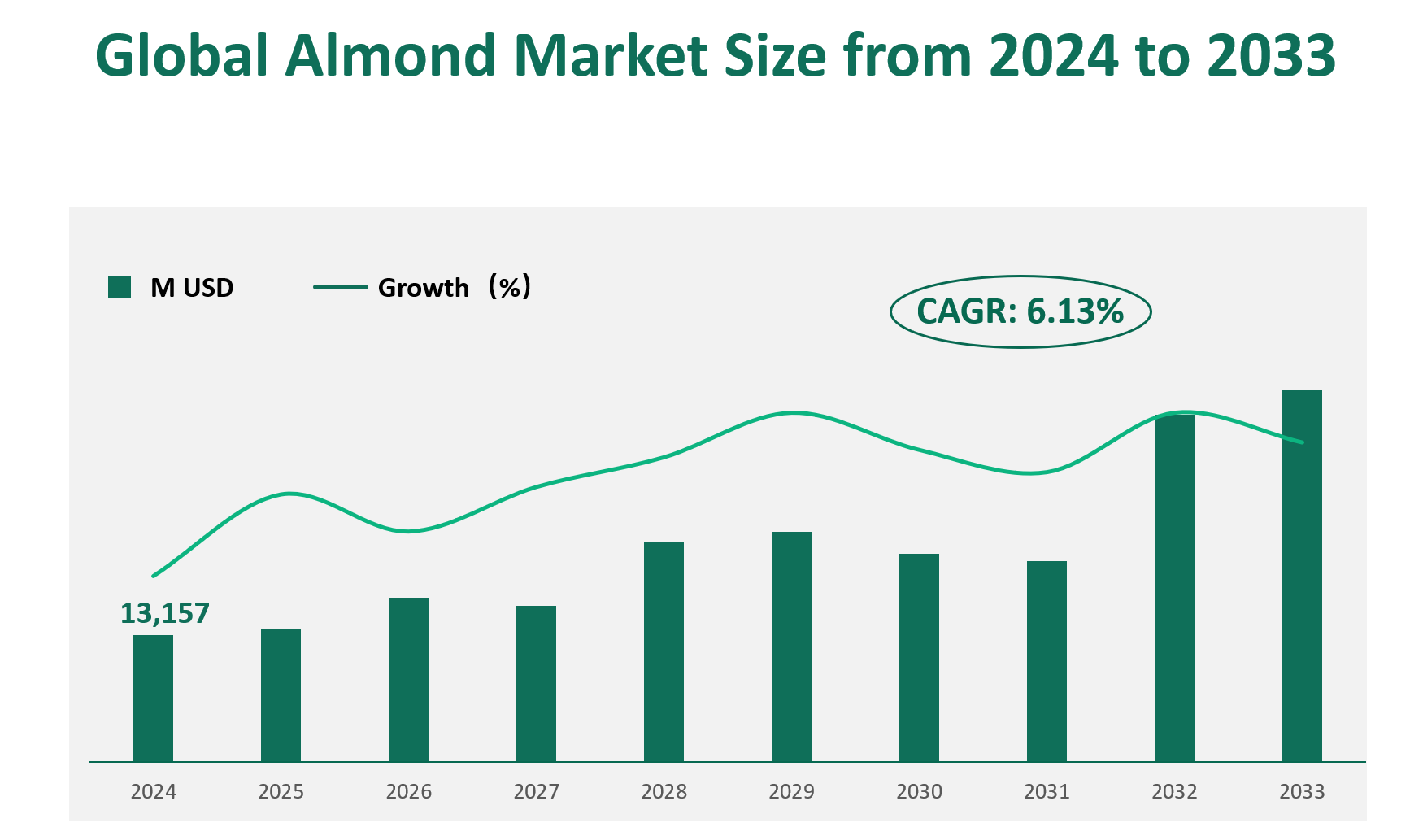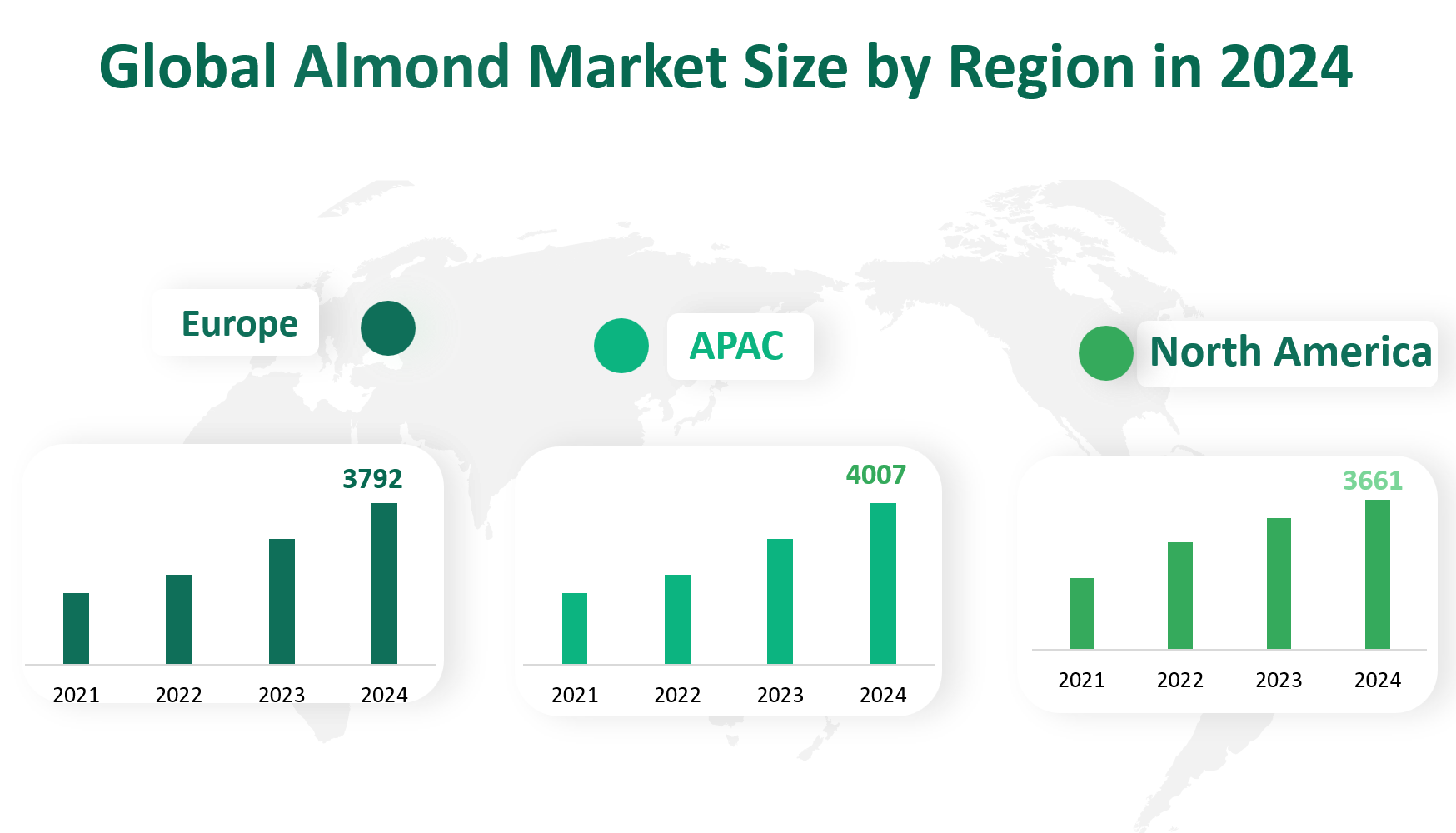1. Global Almond Market Insight Analysis
In 2024, the global almond market revenue is projected to reach $13,157 million, with a Compound Annual Growth Rate (CAGR) of 6.13% from 2024 to 2033.
Almonds are a type of edible drupe, specifically the seed of the almond tree. They are primarily harvested in regions such as the United States, Australia, and Spain. Almonds can be categorized into two main types: shelled and inshell. Shelled almonds have had their hard outer shell removed, revealing the edible kernel inside, while inshell almonds retain their natural protective shell. The almond market is further segmented by application, including direct edible uses, food processing, kitchen ingredients, and other specialized applications.
Almonds are highly valued for their nutritional benefits, being rich in healthy fats, protein, fiber, and various vitamins and minerals. They are widely consumed as snacks, used in baking and cooking, and processed into products such as almond milk, almond flour, and almond butter. The versatility of almonds in both culinary and health applications has significantly contributed to their growing popularity and market expansion.
Figure Global Almond Market Size (M USD) and CAGR (2024-2033)

2. Driving and Limiting Factors of Almond Market Growth
The almond market is experiencing robust growth due to several driving factors. Firstly, strong global demand for almonds is a key driver. Consumers are increasingly seeking healthier food options, and almonds, with their high nutritional value, are becoming a staple in many diets. The market is also benefiting from the diversified application of almonds. Beyond being a popular snack, almonds are used in a wide range of products, including cereals, granola bars, dairy-free milk alternatives, and gourmet dishes. Additionally, policy support in some regions encourages almond cultivation and processing, further boosting the industry.
However, the almond market also faces several limiting factors. Trade frictions have introduced uncertainties, particularly affecting major exporters like the United States. Tariffs imposed by countries such as China and India have impacted almond exports, leading to increased costs and market instability. Environmental challenges, including water scarcity and droughts, are significant concerns for almond growers, especially in regions like California and Spain. These issues can limit production and increase costs. Furthermore, quality assurance is a critical factor, as stringent food safety regulations in major markets like the European Union require rigorous testing and compliance, adding to the complexities and costs for exporters.
3. Technology Innovation and Corporate Mergers and Acquisitions in Almond Market
Technological innovation is playing a crucial role in the almond industry. Advances in water management equipment and soil health practices are helping almond growers optimize their operations and reduce environmental impact. For example, precision irrigation systems are being adopted to minimize water usage while maintaining crop yields. Additionally, bee-friendly practices are being implemented to address the issue of declining bee populations, which are essential for almond pollination. Technological advancements are also improving quality control, with equipment capable of detecting aflatoxin-contaminated or defective almonds, thereby reducing losses and ensuring high-quality output.
Corporate mergers and acquisitions are another significant trend in the almond market. Major players are consolidating their positions through strategic partnerships and acquisitions. For instance, Olam International reorganized its business in 2020 to create two new operating groups: Olam Food Ingredients (OFI) and Olam Global Agri (OGA). This reorganization aims to unlock long-term value and position the company for further growth in key consumer trends and market opportunities. Another example is Select Harvests, which acquired a 1,566-hectare almond orchard in Australia in 2020 to nearly double its output. Such strategic moves are enhancing the market presence and competitiveness of these companies, driving industry consolidation and growth.
4. Global Almond Market Size by Type
Almonds can be categorized into two main types based on their processing: Shelled and Inshell.
Shelled Almonds have been removed from their shells, revealing the edible kernel inside. Shelled almonds are widely used in various applications, including direct consumption as snacks, food processing, and as kitchen ingredients.
Inshell Almonds are sold with their shells intact. They are often preferred by consumers who enjoy the process of cracking open the shell to reveal the nut inside. Inshell almonds are also used in some food processing applications where the shell adds a unique texture or appearance.
The revenue for Shelled almonds in 2024 is forecasted to be around $9,858 million. The revenue for Inshell almonds is projected to be around $3,299 million in 2024.
Table Global Almond Market Size by Type in 2024
5. Global Almond Market Size by Application
Direct Edible: Almonds consumed directly as snacks, often in their raw or roasted form. This category includes salted, roasted, and flavored almonds. The revenue for Direct Edible almonds is forecasted to be around $7389 million in 2024.
Food Processing: Almonds used as ingredients in processed foods, such as cereals, granola bars, almond milk, and confectionery products. The revenue for Food Processing almonds is projected to be around $2615 million in 2024.
Kitchen Ingredients: Almonds used in cooking and baking, such as almond flour, almond butter, and whole or sliced almonds added to recipes. The revenue for Kitchen Ingredients is expected to be around $2974 million in 2024.
Table Global Almond Market Size by Application in 2024
Application | Market Size (M USD) 2024 |
Direct Edible | 7389 |
Food Processing | 2615 |
Kitchen Ingredients | 2974 |
Other | 179 |
6. Global Almond Market by Top Regions
North America is a significant player in the almond market, with a projected revenue of $3,661 million in 2024. The United States, in particular, is a major producer and consumer of almonds, accounting for the majority of the region’s revenue. The strong domestic demand, coupled with exports to other countries, drives the region’s market value.
Europe is another major market, with a projected revenue of $3,792 million in 2024. Europe’s almond market is characterized by high demand for premium and processed almond products. Countries like Spain and Italy are significant producers and exporters of almonds, contributing to the region’s overall revenue.
Asia-Pacific is the fastest-growing region in the almond market, with a projected revenue of $4,007 million in 2024. The region’s growth is fueled by increasing disposable incomes, rising health consciousness, and expanding urbanization in countries like China and India.
Latin America is expected to generate a revenue of $391 million in 2024. While the region’s market is smaller compared to North America, Europe, and Asia-Pacific, it is still an important market with significant growth potential.
Middle East and Africa is projected to have a revenue of $1,305 million in 2024. The region’s market is driven by the increasing demand for almonds in countries like Turkey, Saudi Arabia, and the UAE.
Figure Global Almond Market Size by Region in 2024

7. Global Almond Market Analysis by Major Players
7.1 Blue Diamond
Introduction and Business Overview: Blue Diamond is the world’s largest almond processing and marketing company. Established in 1910, it is headquartered in California, USA. Blue Diamond is renowned for its high-quality almond products and innovative marketing strategies.
Products Offered: Blue Diamond offers a wide range of almond products, including whole natural almonds, shelled almonds, almond flour, almond butter, and almond milk. The company is also known for its flavored and roasted almond snacks.
7.2 Olam International
Introduction and Business Overview: Olam International is a leading food and agri-business with a global presence. Established in 1989, it is headquartered in Singapore. The company is known for its diverse portfolio of food products, including almonds, cocoa, coffee, and edible nuts.
Products Offered: Olam International offers a variety of almond products, including shelled and inshell almonds, almond slices, almond flour, and almond oil. The company sources its almonds from its own orchards in Australia and California, as well as from other growers.
7.3 Wonderful Pistachios & Almonds
Introduction and Business Overview: Wonderful Pistachios & Almonds is a major grower and processor of almonds and pistachios. Established in 1989, it is part of The Wonderful Company, a privately held company with a diverse portfolio of agricultural products.
Products Offered: The company offers a range of almond products, including shelled and inshell almonds, almond slices, almond flour, and almond milk. Wonderful Pistachios & Almonds is also known for its flavored and roasted almond snacks.
7.4 Select Harvests
Introduction and Business Overview: Select Harvests is Australia’s largest vertically integrated nut and health food company. Established in 1983, it is headquartered in Victoria, Australia. The company is known for its high-quality almond products and sustainable farming practices.
Products Offered: Select Harvests offers a variety of almond products, including shelled and inshell almonds, almond slices, almond flour, and almond milk. The company also offers organic almond products.
7.5 Hilltop Ranch
Introduction and Business Overview: Hilltop Ranch is one of the largest privately-owned processors of almonds. Established in 1980, it is headquartered in California, USA. The company is known for its high-quality almond products and extensive processing capabilities.
Products Offered: Hilltop Ranch offers a wide range of almond products, including shelled and inshell almonds, almond slices, almond flour, and almond butter. The company also offers organic and conventional almond products.

